Post by brillbilly on Jan 27, 2010 6:45:52 GMT 10


The Great Pyramid (the Pyramid of Khufu, or Cheops in Greek) at Gizeh, Egypt,
demonstrates the remarkable character of its placement on the face of the Earth.
The Pyramid lies in the center of gravity of the continents. It also lies in the exact center
of all the land area of the world, dividing the earth's land mass into approximately equal quarters.

The Plate XX from an original 1877 copy of
Piazzi Smyth's "Our Inheritance in the Great Pyramid".
Charles Piazzi Smyth (1819-1900) was Astronomer Royal for Scotland
and a respected Scientist.
The north-south axis (31 degrees east of Greenwich) is the longest land meridian, and the east-west axis (30 degrees north) is the longest land parallel on the globe. There is obviously only one place that these longest land-lines of the terrestrial earth can cross, and it is at the Great Pyramid! This is incredible, one of the scores of features of this mighty structure which begs for a better explanation.
Khufu Pyramid Statistics
A total of over 2,300,000 (or only 590,712)* blocks of limestone and granite were used in its
construction with the average block weighing 2.5 tons and none weighing less than 2 tons.
The large blocks used in the ceiling of the King's Chamber weigh as much as 9 tons.
Construction date (Estimated): 2589 B.C..
Construction time (Estimated): 20 years.
Total weight (Estimated): 6.5 million tons.
The estimated total weight of the structure is 6.5 million tons!

Original entrance of the Great Pyramid.
Massive blocks of limestone form a relieving arch over the entrance.
The base of the pyramid covers 13 acres, 568,500 square feet and
the length of each side was originally 754 feet, but is now 745 feet.
The original height was 481 feet tall, but is now only 449 feet.
The majority of the outer casing, which was polished limestone,
was removed about 600 years ago to help build cities and mosques
which created a rough, worn, and step-like appearance.
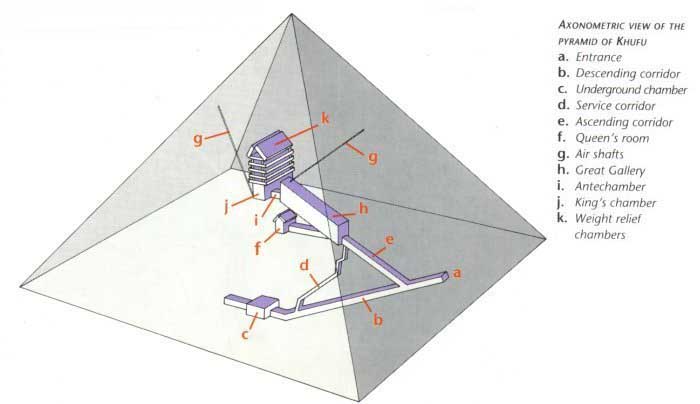
* According to Socrates G. Taseos, the actual number of stones used to build the Great Pyramid is only 590,712.
In his book Back in Time 3104 B.C. to the Great Pyramid- Egyptians Broke Their Backs to Build It- How the Great Pyramid Was Really Built
he presents results of his computer calculations. The following is derived from the book mentioned above.
The base measurements of the Great Pyramid are: north - 755.43 ft; south -
756.08 ft; east - 755.88 ft; west - 755.77 ft. These dimensions show no two
sides are identical; however, the distance between the longest and shortest
side is only 7.8 inches.
Each side is oriented almost exactly with the four Cardinal points. The
following being the estimated errors: north side 2'28" south of west; south
side 1'57" south of west; east side 5'30" west of north; and west side 2'30"
west of north.
The four corners were almost perfect right angles: north-east 90degrees 3'
2"; north-west 89 degrees 59'58"; south-east 89 deg 56'27"; and south-west
90 deg 0'33".
When completed, it rose to a height of 481.4 ft., the top 31 feet of which
are now missing. It's four sides incline at an angle of about 51deg. 51 min.
with the ground. At its base, it covers an area of about 13.1 acres. It was
built in 201 stepped tiers, which are visible because the casing stones have
been removed. It rises to the height of a modern 40-story building.
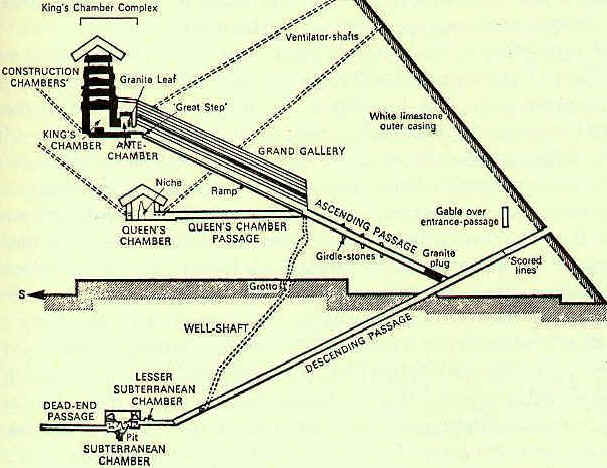
THE BEDROCK AND CORE
The pyramid is built partly upon a solid, large, bedrock core and a platform
of limestone blocks which can be seen at the northern and eastern sides. The
builder of this pyramid was very wise to choose this site because most of
the stones, with the exception of the casing stones, some granite and basalt
stones, could be cut right on the spot and in the nearby quarry. This
practical choice made it possible to reduce considerably the time and
back-breaking labor needed to drag the stones from distant quarries across
the Nile.
The first Step of the pyramid rests on a platform of finely finished
limestone blocks. These blocks are approximately 2.5 ft x 10 ft x 10 ft..
They project beyond the outer edges of the first Step's Casing Stones an
average of 2 feet on all sides. This platform is so flat that the official
survey of the Egyptian Government found that it was less than ½ of an inch
from being level. The removal of several platform stones showed that the
bedrock had been cut and leveled to receive each individual stone, sometimes
as deep as 1 to 2 inches.
On the north side the platform stones have been laid at an irregular angle,
each socket being carefully cut to receive the next stone. One explanation
for this irregularity of stone placement is that these northern platform
stones will have greater resistance to sliding from the downward and
horizontal pressures of the pyramid's face.
The many surveys done on the pyramid proved that the Egyptians located the
sides of the pyramid along the four Cardinal Points with extreme accuracy.
Whether they used the stars, and/or the rising and setting sun, cannot be
determined. One this is certain, that whatever method they used was direct
and very simple.
Once the sand, gravel and loose rocks had been removed, down to the solid
bedrock of the plateau, the whole pyramid site was open-cast quarried into
blocks, leaving a square core for the center of the pyramid (the core is
approximately 412.7 ft square, and rises approx. 46.25 feet high). These
blocks were then stored outside a low wall; made of mortared stone that
surrounds the core (the outside dimensions of the wall are approx. 887.3
feet square). Today there still remains the foundation of this wall on the
north, south and west sides of the pyramid, at an average distance of 65
feet from the outer edge of the base casing stone.
This core gives the pyramid stability from the downward and horizontal
forces that will develop from the superimposed loads of blocks of stones
that are piled up, as the pyramid rises. Also, from the prevailing
north-west winds that exert enormous pressures on the huge areas of the
pyramid's faces, thus increasing these forces further.
Leveling of the entire pyramid site was accomplished by flooding the area
inside the wall with water, leaving just the high spots. These them were cut
down to the level of the surface of the water. Next, some of the water was
released and the high spots again were cut down to the water's surface. This
process was repeated until the entire pyramid site, between the core and the
four walls, was leveled down to the base of the pyramid's platform.
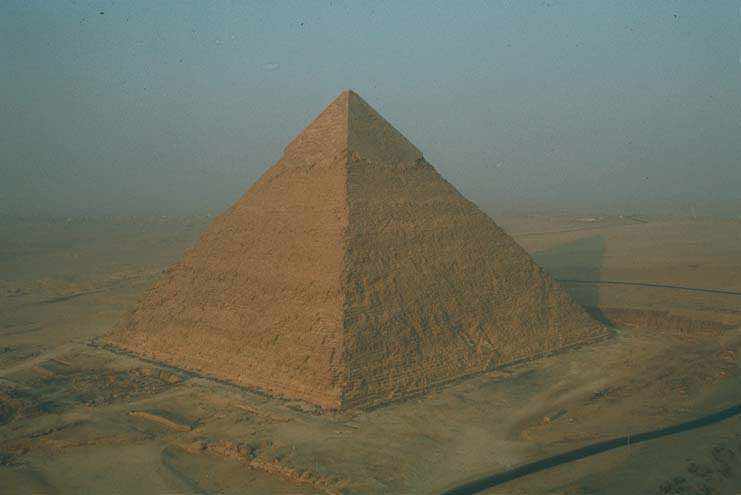
THE CASING STONES
A few of the fine limestone casing blocks remain at the base of the northern
side and show how accurately the stones were dressed and fitted together.
The core masonry, behind the casing stones, consists of large blocks of
local limestone, quarried right on the spot, built around and over the
bedrock core. The size of this core cannot be determined, since it is
completely covered by the pyramid.
The casing stones were of highly polished white limestone, which must have
been a dazzling sight. Unlike marble, which tends to become eroded with time
and weather, limestone becomes harder and more polished.
HOW MANY BLOCKS DID IT ACTUALLY TAKE TO BUILD
THE GREAT PYRAMID?
Most books and encyclopedia state that there are 2.3 million blocks of stone
in the Great Pyramid of Khufu (Cheops), with no mention of method used to
figure this.
Socrates determined the size and weight of the blocks (a standard block),
and ran a Pascal Computer Program (a mathematical model of all the blocks of
stone needed; written by the author to optimize the sizes and weights of the
stones) to come up with the real number of blocks used. Since the volume of
passageways and internal chambers are very small compared to the high volume
of the pyramid, they are ignored at this time, just as though the pyramid
was built of solid stone blocks with mortared joints.
THE SIZE OF THE BLOCKS
The size of the blocks are based on a chance discovery in 1837 by Howard
Vyse. He found two of the original side casing blocks at the base of the
pyramid, 5 ft x 8 ft x 12 ft, with an angle of 51 degrees, 51 minutes cut on
one of the 12 ft. sides. Each of these stones weighed (5 x 8 x 12)/2000 =
39.9 tons before the face angle was cut. These originally were used for the
side casing stones of Step No. 1, in the Pascal computer program. The sizes
of all the other blocks were scaled from these two original blocks of the
remaining Steps 2 to 201.
THE GREAT PYRAMID'S DIMENSIONS AND THEIR LAYOUT
One acre = 43,560 sq. ft, or 208.71 feet on a side.
For the pyramid's base, length = width = (square root of 13.097144 acres) x
208.71 feet = 755.321 feet. Or 755.321 x 12 = 9063.85 inches.
Height = (755.321 x tangent 51deg 51 min)/2 = 480.783 feet. Or 480.783 x 12
= 5769.403 inches.
For the cap stone base: length = width = (32.18 x 2)/tangent 51deg 51 min =
50.55 inches.
The average size of a pyramid stone = (5 x 8 x 12)
The average side measurement, at the base = 759.3 ft.
The height used was 201 steps high, or 480 feet. (This is minus the height
of the Capstone, which was one piece in itself.
The number reached by the Pascal computer program was 603,728 blocks used.
The solid core takes up the space of 13,016 stones.
So, the actual number of stones used to build the Great Pyramid is 603,728 -
13,016 = 590,712.
This figure is (2,300,000 - 590,712) = 1,709,288 blocks less than the often
published 2.3 million value.
NUMBER OF VARIOUS BLOCKS OF STONE USED
TO BUILD THE GREAT PYRAMID
Number of platform blocks used (2.5 ft x 10 ft square), equals (759.3 x
759.3(pyramid base)) - (412.7 x 412.7(core base))/(10 x 10(platform block
base)) = 4,062.
Number of CORNER Casing stones where the pyramid faces meet equals 201 steps
x 4 sides = 804.
Number of side casing stones equals ((244 x 127) + 8,953) = 39,941.
Due to Bedrock Core, in the center of Step 1 through 10, the total number of
blocks needed is reduced by 13,016.
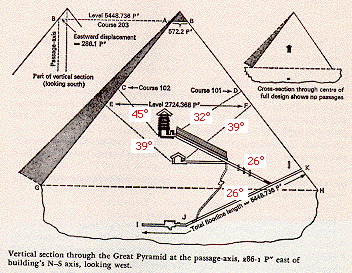
THE NUMBER OF ALL BLOCKS BEHIND
THE CASING STONES EQUALS
(590,712 - 804 - 39,941) = 549,967.
world-mysteries.com/mpl_2.htm
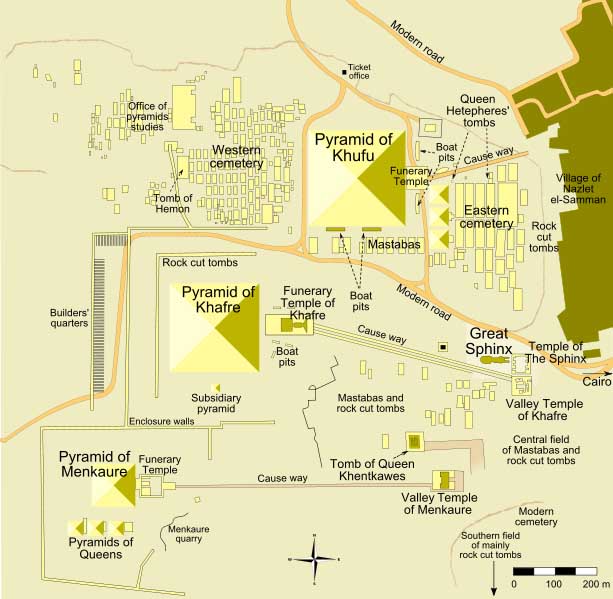
www.crystalinks.com/greatpyramid.html
i love a good mystery



 Happy New Years Everybody!!!
Happy New Years Everybody!!!
